Hornsby Distinguished Lecture 2014 by Professor Shaun Harper
The higher education program helped host Dr. Shaun R. Harper, Hornsby Distinguished Lecture speaker on March 12th at the Professional Development Center of the School of Education. Professor Harper is a tenured faculty member in the Graduate School of Education, Africana Studies, and Gender Studies at University of Pennsylvania, where he also serves as Executive Director of the Center for the Study of Race & Equity in Education. Professor Harper’s research agenda includes race and gender in higher education, Black male college access and achievement, and college student engagement. He has authored over 80 peer-reviewed journal articles and other academic publications. Professor Harper earned his bachelor’s degree from Albany State, a historically Black university in Georgia, and his Ph.D. in higher education from Indiana University.
Professor Harper’s lecture titled, “Getting Black and Latino Student Achievers to and through College” was delivered to a packed audience composed of faculty, students, staff, and members of the community. Professor Harper’s lecture highlighted key findings from a study recently completed in NYC public schools. While the study was based on samples of male students, Professor Harper focused more on what educators did in the 40 public high schools to foster student achievement and create college-going cultures. Professor Harper challenged the tendency of researchers and practitioners to approach the issues of male students of color with a deficit model. He highlighted how simple measures that did not cost much improved retention and completion rates for male students of color at the sites studied.
Professor Harper asserted that institutions of higher education carry a measure of responsibility in making sure that the students graduate. He illustrated his point by demonstrating how universities lose millions when students of color drop out. He argued that in any other business the loss of a few million dollars each year would result in dismissal of the executives, while in higher education, it barely raises eyebrows. He called on higher education practitioners to take a page from his study’s findings that students can be motivated to stay in school and graduate with innovative measures that cost very little.
"I was most impressed by Shaun's orientation to examination of successes. Since entering the School of Education, I have repeatedly heard frustrations with what my colleagues are calling a "deficit model" approach to educational research. My academic background in critical theory has also led me to mostly focus on problems, errors, inequities, and injustices. While that focus will always be important, Shaun presented the profound benefits and emancipatory potentials of gaining better understanding of what kinds of practices are working in education, because many are." Jamison Miller, PhD Student, EPPL Higher Ed
The full text of Professor Harper’s study can be found here: SUCCEEDING IN THE CITY REPORT.
About the Hornsby Distinguished Lecture Series
This lecture is supported through a generous endowment established by the late Robert Stanley Hornsby ’41, J.D. ’49 and Mrs. Lois Saunier Hornsby with the purpose of enriching a sense of unity for those engaged in the wonders of teaching and learning.

